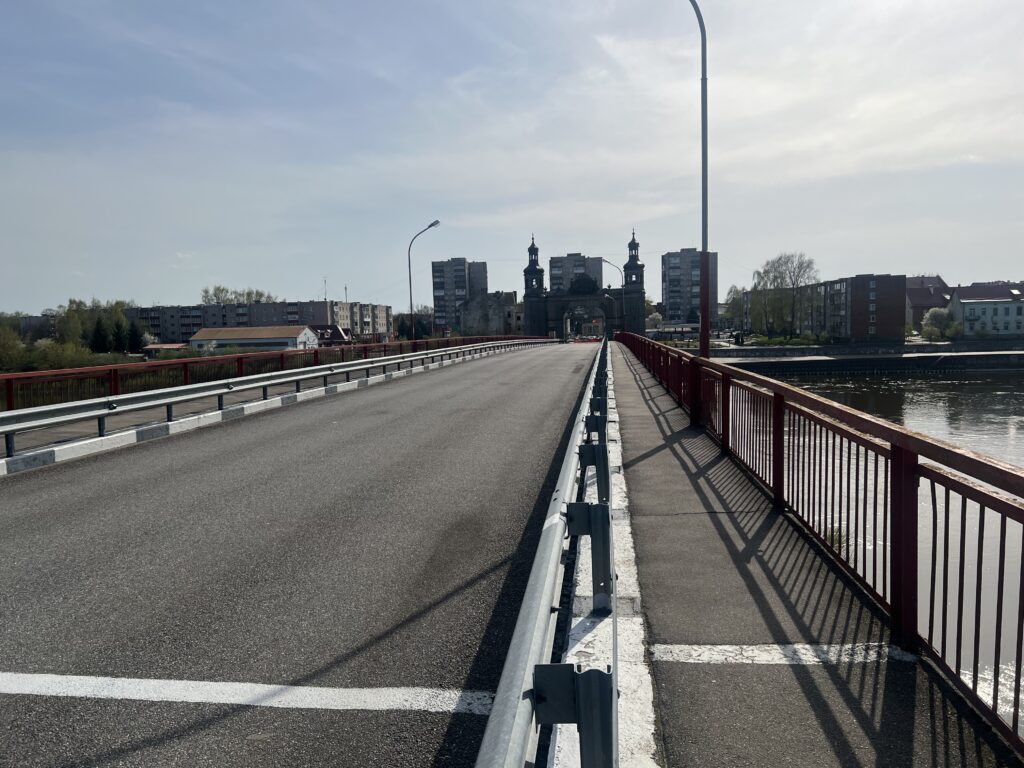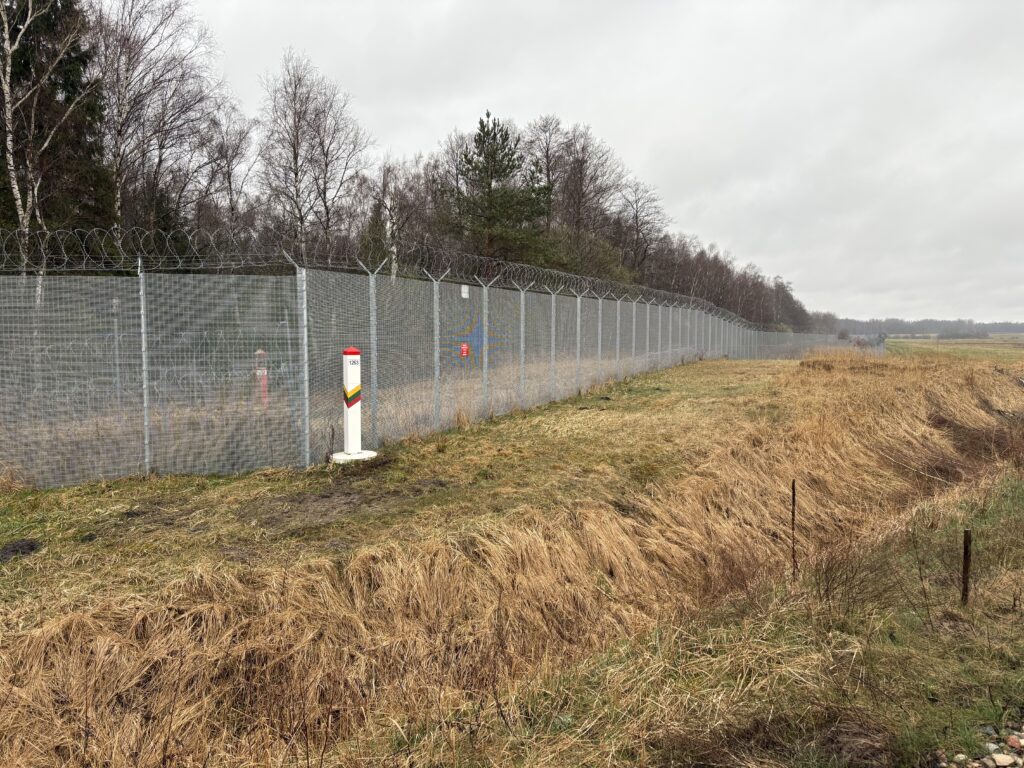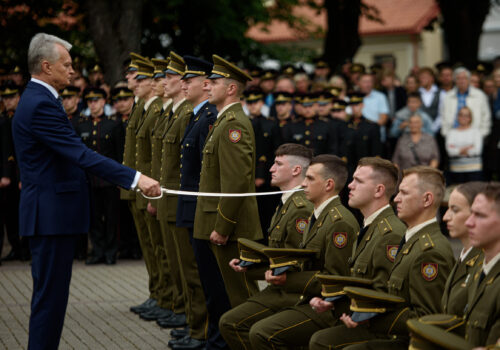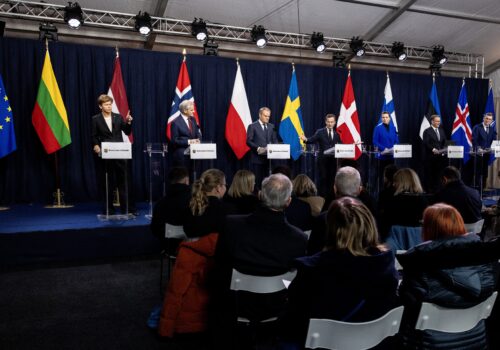Dispatch from the Kaliningrad border: Russia is fighting a long battle of attrition with the West
PANEMUNĖ, Lithuania—Standing at a border checkpoint between Lithuania and Kaliningrad on an unseasonably warm spring day, I can see the Russian “Z” for victory emblazoned on a building just across the Neman River. In defiant response, oversized Lithuanian and Ukrainian flags fly on the Lithuanian side atop an old tower in an otherwise empty field.
Most days are quiet at the crossing, border guards tell me. Motor traffic was closed on the bridge after Russia’s full-scale invasion of Ukraine in 2022. The checkpoint primarily serves pedestrians moving back and forth to see family. But the guards know intuitively that things could change at any moment with Russia, as they have many times before.
Today, Lithuanians see a Russia that is in it for the long haul in a battle of attrition with the West. They see a Russia whose society and economy are adjusting in real time to a program of redoubled military recapitalization, endemic economic hardship, and the loss of a generation of young men killed or injured fighting against Ukraine.

Similarly, at the 422-mile border between Belarus and Lithuania, the Lithuanian government has invested hundreds of millions of dollars to fortify the frontier against a range of threats. The Lithuanians view the Belarusian border as an extension of Russia’s campaign of low-grade aggression against the Baltic states, which Moscow is carrying out at the same time it works to shrink Belarusian sovereignty and agency.
The border with Belarus is a hive of activity. Lithuanian border guards battle cigarette smuggling via air balloons, incursions by drones, and waves of migrants attempting to cross into Lithuania. It is hard to know what is simple criminal activity, what are actions directed by Minsk to test Lithuania’s security, and what are both. The effect is the same—nonstop heat on Lithuania along most of its southern and eastern borders.

It is worth remembering that Lithuania has outpaced the United States and nearly all other NATO allies in ramping up its defense spending to nearly 5 percent of gross domestic product (GDP), which it will hit as soon as next year. Lithuania spent only around 1 percent of GDP a decade ago. These efforts are not without societal costs and tradeoffs, of course, and it remains to be seen what elements will be financially and politically sustainable over time.
In addition to increasing its own military spending, Lithuania has, in the space of just one year, spent millions in national funds to expand the burgeoning training center at Pabradė for enhanced use by US and other allied troops. It aims to build its air defenses, better integrate its ground forces, and increase its mobility, countermobility, and logistics capabilities. It is taking steps to improve command and control and beef up air, naval, and special operations forces. Lithuania is also on track to support a historic deployment of some five thousand German troops and their families by 2027.
The Trump administration has often maintained that countries must pull their own weight as a prerequisite for its support and respect. The United States maintains a presence of only around one thousand soldiers in Lithuania, with talk in the air in Washington of possible changes or reductions to US force posture in Europe in the interest of focusing on the Indo-Pacific. It is unclear how or whether being a high-performing ally will be factored in by the Trump administration as it reviews military posture options. But pulling back from such deployments in front-line states would be short-sighted, amid Russia’s long game against the West.
For its part, Lithuania has the unenviable task of navigating the current European impulse to be more strategically independent from the United States while advocating for long-term NATO cohesion and preserving its bilateral relationship with the United States. It will not be easy. Regardless of the nature of scope of ally support, the country must continue to strengthen its armed forces, diversify its industrial base, harden critical infrastructure, and protect its borders. Its recent deals to purchase forty-four German Leopard 2A8 tanks and support German defense manufacturer Rheinmetall’s construction of a 155 mm artillery shell plant are a start, but much work needs to be done.
Just a trickle of pedestrians move across the aging bridge between Lithuania and Kaliningrad now. As one border guard observed looking toward the Kaliningrad side, “Lithuania, we know Russia by now.” Russia has repeatedly shown itself to be a threat to its neighbors and hostile to their ambitions for closer ties with the United States and the rest of Europe.
Even if the war in Ukraine is ultimately resolved, Russia will not give up its strategic intentions in Europe and around the globe. Ongoing hybrid attacks attributed to Russian and Belarusian pressure at the Lithuanian border—and across Europe—make that clear. As it looks to ensure its own interests and the geopolitical stability they rely on, the United States would be wise to keep the view from Panemunė in mind.
Tressa Guenov is the director for programs and operations and a senior fellow at the Scowcroft Center for Strategy and Security at the Atlantic Council. Previously, she was the US principal deputy assistant secretary of defense for international security affairs in the Office of the Under Secretary of Defense for Policy at the US Department of Defense.
Note: The Atlantic Council delegation’s visit to Lithuania was sponsored by the Lithuanian Ministry of National Defense.
Further reading
Thu, Jan 2, 2025
Lithuania prioritizes defense spending amid growing Russian threat
UkraineAlert By Agnia Grigas
Lithuania's new government is planning to increase defense spending as the Baltic nation faces up to the growing threat posed by Putin's Russia amid uncertainty over the US role in European security, writes Agnia Grigas.
Wed, Feb 5, 2025
Baltic states unplug from Russia’s power grid—but Moscow still looms over critical infrastructure
New Atlanticist By Justina Budginaite-Froehly
Breaking from the Russian system, Estonia, Latvia, and Lithuania are about to synchronize their electricity systems with the Continental Europe Network.
Wed, Dec 4, 2024
How the Nordic-Baltic states are leading the way on European security
New Atlanticist By Anna Wieslander
Denmark, Estonia, Finland, Iceland, Latvia, Lithuania, Norway, and Sweden are becoming increasingly significant to security on the continent.



